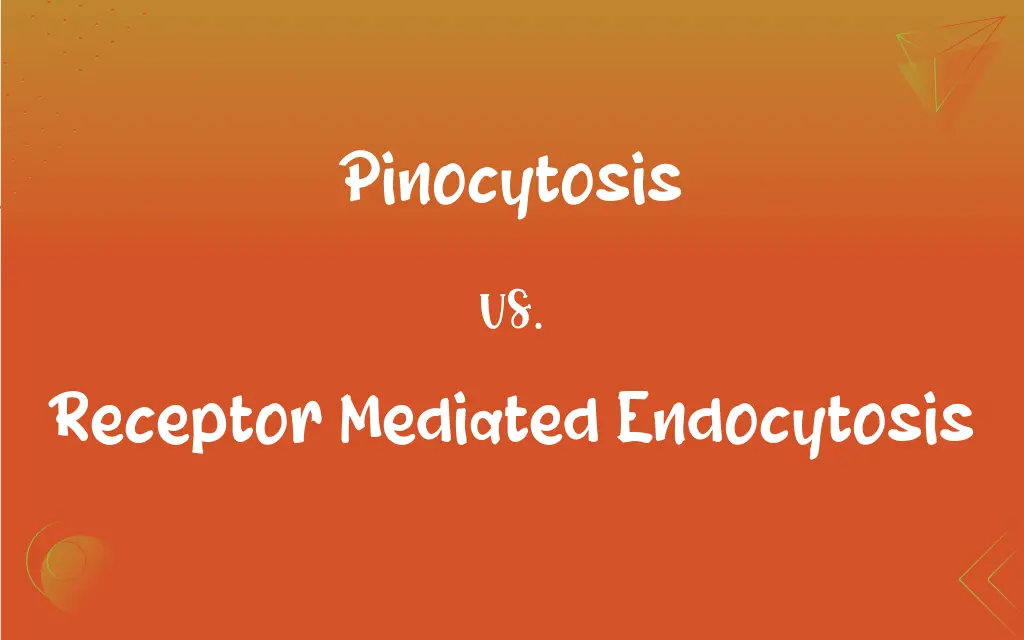Pinocytosis vs. Receptor Mediated Endocytosis: What's the Difference?
Edited by Aimie Carlson || By Harlon Moss || Updated on October 30, 2023
Pinocytosis is cellular "drinking" of extracellular fluid, while receptor mediated endocytosis involves specific binding to receptors for selective intake.

Key Differences
Pinocytosis is a type of endocytosis where cells engulf extracellular fluid, along with any dissolved solutes, by wrapping them within the cell membrane and bringing them into the cell. This is often referred to as cellular "drinking". It's a non-specific process, meaning the cell takes in whatever is present in the surrounding fluid. On the other hand, receptor mediated endocytosis is a specific form of endocytosis where cells absorb specific molecules based on the presence of matching receptors on the cell surface.
In pinocytosis, small vesicles form from the cell membrane and pinch off to carry the extracellular fluid into the cell's interior. This process happens continually in many cells, allowing them to sample and respond to their environment. In contrast, receptor mediated endocytosis relies on receptors on the cell surface to bind to specific ligands or molecules. Once these receptors are bound to their respective ligands, the cell membrane wraps around them and forms a vesicle to bring them into the cell.
Pinocytosis is essential for cells to maintain their fluid balance and to take in nutrients. It doesn't discriminate between different molecules present in the fluid. Receptor mediated endocytosis, however, provides cells with the ability to selectively take in specific molecules that might be present in low concentrations, ensuring that the cell gets what it specifically needs.
The efficiency of pinocytosis can vary depending on the cell type and conditions. Some cells might engage in this process more actively than others. Receptor mediated endocytosis, given its specificity, is highly efficient. It ensures that only particular molecules are brought into the cell, minimizing wasteful intake.
Comparison Chart
Specificity
Non-specific intake of extracellular fluid
Specific intake based on receptor binding
ADVERTISEMENT
Vesicle Formation
Frequent, continuous in some cells
Formed after receptor-ligand binding
Main Function
Maintain fluid balance, nutrient uptake
Selective uptake of specific molecules
Concentration Sensitivity
Not sensitive to ligand concentration
Can uptake molecules in low concentration
Molecular Discrimination
No discrimination between molecules
Only specific molecules are taken in
Pinocytosis and Receptor Mediated Endocytosis Definitions
Pinocytosis
Pinocytosis is a non-selective endocytic mechanism.
Unlike other methods, pinocytosis doesn't differentiate between the types of molecules it engulfs.
ADVERTISEMENT
Receptor Mediated Endocytosis
Receptor mediated endocytosis is a selective cellular intake mechanism based on receptor-ligand binding.
Cholesterol is taken into cells through receptor mediated endocytosis.
Pinocytosis
Pinocytosis is essential for nutrient absorption and fluid balance in many cells.
Without pinocytosis, cells would struggle to maintain their necessary fluid levels.
Receptor Mediated Endocytosis
Receptor mediated endocytosis involves vesicle formation post receptor binding.
Following the receptor-ligand interaction, receptor mediated endocytosis encapsulates the molecule in a vesicle for cellular uptake.
Pinocytosis
Pinocytosis is the cellular process of ingesting liquid and its solutes.
Through pinocytosis, cells can constantly sample the surrounding fluid.
Receptor Mediated Endocytosis
Receptor mediated endocytosis is an efficient way for cells to absorb necessary molecules.
Vitamins, in certain cases, are brought into the cell via receptor mediated endocytosis.
Pinocytosis
Pinocytosis forms small vesicles from the cell membrane to transport fluid inwards.
When a cell undergoes pinocytosis, you can observe tiny vesicles transporting liquid inside it.
Receptor Mediated Endocytosis
Receptor mediated endocytosis allows cells to capture specific molecules from their environment.
With receptor mediated endocytosis, cells can specifically uptake molecules even in low concentrations.
Pinocytosis
Pinocytosis involves cells "drinking" their extracellular environment.
Cells use pinocytosis to balance their internal and external fluid levels.
Receptor Mediated Endocytosis
In receptor mediated endocytosis, cell surface receptors are key for specific molecular intake.
When a specific ligand binds to its receptor, receptor mediated endocytosis is triggered.
Pinocytosis
Introduction of fluids into a cell by invagination of the cell membrane, followed by formation of vesicles within the cell.
Pinocytosis
(biology) A form of endocytosis in which material enters a cell through its membrane and is incorporated in vesicles for digestion.
Pinocytosis
Process by which certain cells can engulf and incorporate droplets of fluid
FAQs
Can pinocytosis lead to waste intake by the cell?
Since pinocytosis is non-specific, cells may ingest unneeded or even harmful molecules.
How does receptor mediated endocytosis differ from pinocytosis?
Receptor mediated endocytosis is selective based on receptor binding, whereas pinocytosis is a non-specific intake of fluid.
What are some molecules taken in by receptor mediated endocytosis?
Cholesterol, certain vitamins, and specific proteins are examples of molecules taken in this way.
Are there diseases associated with receptor mediated endocytosis malfunction?
Yes, some genetic disorders can affect the functionality of receptors, impacting the efficiency of this process.
How do nutrients enter cells through pinocytosis?
Nutrients dissolved in extracellular fluid can be engulfed by pinocytosis and then processed within the cell.
What triggers receptor mediated endocytosis?
The binding of a specific ligand to its corresponding cell surface receptor triggers the process.
Can receptor mediated endocytosis be observed under a microscope?
With advanced microscopy techniques, one can observe the "coated pits" and vesicles characteristic of this process.
How do cells ensure specific intake in receptor mediated endocytosis?
The presence of specific receptors on the cell surface ensures that only certain molecules bind and are taken in.
Does pinocytosis require energy?
Yes, like other forms of endocytosis, pinocytosis requires energy, usually from ATP.
How do cells dispose of unneeded receptors in receptor mediated endocytosis?
After endocytosis, receptors can be recycled back to the cell surface or directed to lysosomes for degradation.
How do cells regulate receptor mediated endocytosis?
Cells can regulate the number and type of receptors on their surface, affecting uptake specificity and efficiency.
Is pinocytosis the same in all cell types?
No, the rate and extent of pinocytosis can vary between different cell types.
Can pinocytosis be stimulated or inhibited by external factors?
Yes, certain conditions or signaling molecules can increase or decrease the rate of pinocytosis.
What is pinocytosis?
Pinocytosis is the cellular "drinking" process where cells engulf extracellular fluid and its dissolved solutes.
Why is receptor mediated endocytosis considered efficient?
It allows for the selective uptake of specific molecules, even if they're in low concentrations.
Are the vesicles formed in pinocytosis and receptor mediated endocytosis similar?
While both form vesicles, those in receptor mediated endocytosis often have a distinctive "coated pit" appearance due to the presence of receptors and bound molecules.
Is receptor mediated endocytosis always beneficial for the cell?
While often beneficial, certain pathogens can exploit this process to enter cells, leading to infections.
Is pinocytosis a form of endocytosis?
Yes, pinocytosis is a type of endocytosis focused on ingesting liquids.
Do all cells undergo pinocytosis?
Most cells undergo pinocytosis to some degree, but the frequency and intensity can vary.
How do cells handle the fluid they ingest via pinocytosis?
Cells can process the ingested fluid in lysosomes, extract nutrients, and expel waste through exocytosis.
About Author
Written by
Harlon MossHarlon is a seasoned quality moderator and accomplished content writer for Difference Wiki. An alumnus of the prestigious University of California, he earned his degree in Computer Science. Leveraging his academic background, Harlon brings a meticulous and informed perspective to his work, ensuring content accuracy and excellence.
Edited by
Aimie CarlsonAimie Carlson, holding a master's degree in English literature, is a fervent English language enthusiast. She lends her writing talents to Difference Wiki, a prominent website that specializes in comparisons, offering readers insightful analyses that both captivate and inform.
































































